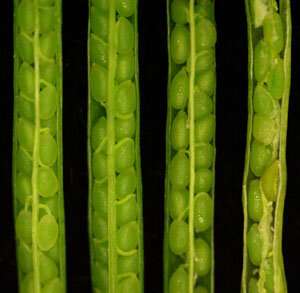Figure 1: Mutations of ubiquitination and autophagy genes cause severe growth defects, as these photographs of premature seeds in seed pods show (left to right: wild type, autophagy mutant, ubiquitination mutant, and double mutant). Credit: RIKEN Center for Sustainable Resource Science
Plant cells use an unknown mechanism to mark damaged chloroplasts for destruction, RIKEN biologists have discovered. This finding could eventually lead to more sustainable agriculture through the reduced use of fertilizers.
Cells prevent damaged organelles and dysfunctional proteins from accumulating by breaking them down. This also allows the component molecules to be reused.
There are two main degradation pathways. In the ubiquitin–proteasome system for degrading proteins, a process known as ubiquitination tags proteins for degradation. Another pathway, autophagy, involves membrane-bound vesicles engulfing damaged proteins or organelles and digesting them for recycling.
Researchers are interested in how these two pathways interact. In mammalian cells, ubiquitination tags mitochondria for degradation via autophagy. A team led by Masanori Izumi of the RIKEN Center for Sustainable Resource Science set out to discover whether a similar process occurs in plant cells for the autophagy of chloroplasts—the organelles where photosynthesis occurs. While some chloroplast proteins are marked for degradation by ubiquitination, it wasn't known whether this process also tags damaged chloroplasts.
The researchers used a combination of mutant analysis, genetic labeling and biochemistry experiments to assess the two ubiquitination genes, PUB4 and SP1, in chloroplast degradation. They found that chloroplast autophagy was not reduced in the pub4 mutant. Likewise, piecemeal autophagy of the components of chloroplasts did not require PUB4. The sp1 mutants had similar results. The fact that these genes are not required for chloroplast autophagy suggests that the process is independent of ubiquitination.
Izumi was not surprised by these findings. "I suspected that ubiquitination might not be required for chloroplast autophagy, because I thought that an unknown process should be linked to the induction of chloroplast autophagy," he says. Izumi has started a new project to identify the molecules involved in this unknown process.
But the interaction between ubiquitination and autophagy isn't quite that simple. When the team combined the pub4 mutant with mutations of autophagy genes, they found that the plants had more severe phenotypes than the single mutants did individually (Fig. 1). The leaves lost chlorophyll more quickly, and the plants accumulated higher levels of reactive oxygen species and produced fewer seeds. The double mutants also accumulated ubiquitinated proteins—proteins were being marked for degradation but weren't being broken down. Finally, the double mutants were more susceptible to the effects of carbon or nitrogen starvation.
"This shows the importance of the degradation systems for plant growth," says Izumi. "If we can control these degradation systems, we can improve growth or nutrient recycling. That could help reduce fertilization in agriculture, decreasing environmental costs and leading to more sustainable crop production."
More information: Yuta Kikuchi et al. Chloroplast Autophagy and Ubiquitination Combine to Manage Oxidative Damage and Starvation Responses, Plant Physiology (2020). DOI: 10.1104/pp.20.00237
Provided by RIKEN
























